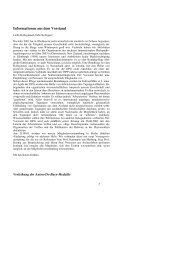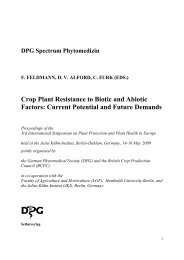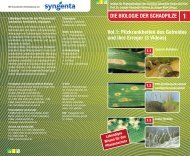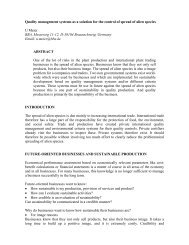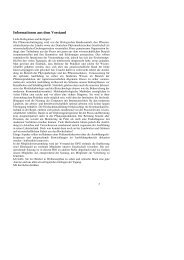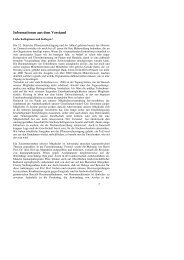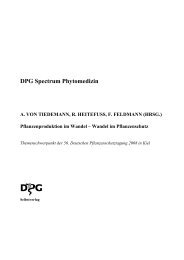PHYTO MEDIZIN Mitteilungen der Deutschen ... - Die DPG
PHYTO MEDIZIN Mitteilungen der Deutschen ... - Die DPG
PHYTO MEDIZIN Mitteilungen der Deutschen ... - Die DPG
Erfolgreiche ePaper selbst erstellen
Machen Sie aus Ihren PDF Publikationen ein blätterbares Flipbook mit unserer einzigartigen Google optimierten e-Paper Software.
crop species. Rye became earlier infected than wheat and triticale if sown at<br />
the same time. Visual inspection of the field revealed that rye plants showed<br />
clear symptoms already early in February whereas wheat and triticale plants<br />
developed symptoms later in March. Both furoviruses tolerate a broad temperature<br />
spectrum un<strong>der</strong> field conditions and once established infection by<br />
these viruses is detectable until the harvest time. In contract to this, the<br />
propagation of the bymovirus WSSMV seems to be restricted to lower temperatures.<br />
Consequently, this virus is detected best at the end of February<br />
until beginning of April. A survey in the cereal growing regions of Saxony-<br />
Anhalt and Lower Saxony revealed that there only SBCMV and WSSMV are<br />
spread. There rye cultivars appear to be more heavily infected than different<br />
cultivars of wheat and triticale.<br />
Dutch-German cooperations in evaluating species demarcation criteria<br />
for tombus- and tymoviruses<br />
R Koenig 1 , JThJ Verhoeven 2 , CWA Pleij 3 and D-E Lesemann 1; 1 Biologische Bundesanstalt,<br />
Institut für Pflanzenvirologie, Mikrobiologie und biologische Sicherheit,<br />
Braunschweig, 2 Plant Protection Service, Wageningen and 3 Leiden Institute of Chemistry,<br />
Leiden University<br />
The VIIIth Report of the International Committee on Taxonomy of Viruses<br />
(ICTV) lists biological, serological and molecular properties as species demarcation<br />
criteria for tombus- and tymoviruses as well as for many other<br />
plant virus genera. In attempts to characterise and classify newly detected<br />
tombus- and tymoviruses we have compared the usefulness of the various<br />
species demarcation criteria for these viruses. Five new tombusvirus isolates<br />
all from the same natural host, i.e. commercially grown statice (Limonium<br />
sinuatum) from various parts of the world, were more or less indistinguishable<br />
in limited host range studies, but by means of immunoelectron microscopy<br />
they were readily distinguished and four of them could be assigned to<br />
various known tombusviruses. Coat protein sequence comparisons indicated<br />
that none of them was exactly identical to one of the previously described<br />
viruses. - In the genus tymovirus total nucleotide and coat protein amino acid<br />
sequence identities revealed similar groupings as earlier serological studies.<br />
The latter, however, tended to suggest much closer relationships than the<br />
molecular data and may fail to recognise a new tymovirus as being distinct.<br />
Thus, a new tymovirus (provisionally named Nemesia ring necrosis virus)<br />
which is widely spread in commercially grown genera in the Scrophulariaceae<br />
and Verbenaceae was serologically barely distinguishable from the<br />
earlier described Scrophularia mottle virus. Molecular studies, however,<br />
38




